The winner – Campaign Monitor
Basic
In this comparison, Campaign Monitor wins six out of eleven rounds. One round ends in a tie, and there are four aspects where tinyEmail outperforms Campaign Monitor. Carry on reading and learn how these two platforms compare with each other.
What Campaign Monitor features are better than tinyEmail?
- Marketing automation options
- More segmentation options
- Email campaign analytics
- SMS channel for the US market
- Marketing automation is basic
- Segmentation for ecommerce needs further development
- Pretty basic analytics
- Email channel only
Given the endless number of email marketing tools, finding the ideal software can take time and effort, especially for small businesses. Campaign Monitor and tinyEmail are two of the top email marketing tools you may have considered.
Founded in 2004, Campaign Monitor is an established email marketing platform with thousands of customers.
tinyEmail, on the other hand, is a fairly new email marketing tool launched in 2020 that has gained popularity for its simplicity, ease of use, and overall affordability.
So which one is best for your business, tinyEmail or Campaign Monitor?
Campaign Monitor vs tinyEmail: A quick overview
Campaign Monitor and tinyEmail are strong contenders because they target similar audiences. However, each software has its unique features that set one apart from the other.
Campaign Monitor has an easy-to-use email builder, allowing businesses to design personalized email campaigns. Campaign Monitor doesn’t track ecommerce data. That’s why it’s more suitable for non-ecommerce users.
Conversely, tinyEmail is more popular for Shopify users. The software is rated 4.6 stars out of five on the Shopify App Store, making it popular.
The table of features below compares tinyEmail vs Campaign Monitor’s key features side by side. Here’s what that looks like.
This next section gets into the details of how Campaign Monitor and tinyEmail’s critical features compare.
Campaign Monitor vs tinyEmail comparison: Feature by feature
In this feature-by-feature comparison, we discuss Campaign Monitor vs tinyEmail side by side, accessing their similarities and differences. We’ll go on to name the winner for each feature and why we think they performed the best in that section.
Ease of getting started
A great email marketing platform should have a user interface that is easy to navigate and a simplified signup process. Here’s how Campaign Monitor vs tinyEmail compares in terms of ease of use.
The signup process was pretty straightforward with both tools. However, tinyEmail asks you more questions during signup making the process a bit more lengthy.
You’ll need to upload your logo, brand colors, personal details, and even your credit card information in the initial steps. We found it a bit odd that you’d need to provide your credit card details even though tinyEmail has a free plan.
You also don’t get the option to choose their free plan upfront. The tinyEmail team only sends you an email later, with the option to sign up without your credit card details, which can be confusing.
Other than that, everything else on tinyEmail is smooth: the settings, navigation, verification process, and usability.
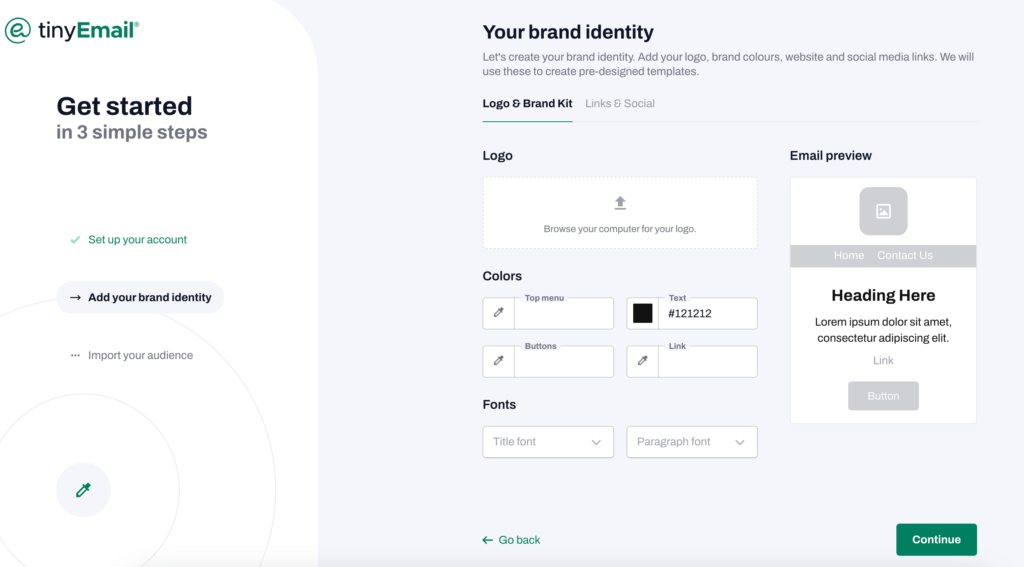
Campaign Monitor needs to catch up in these aspects in comparison. This is because, while the interface seems clear, it’s difficult to locate some standard functions without help from the Help Center.
For instance, it’s hard to trace the signup form function and segmentation on Campaign Monitor’s dashboard. This makes navigation a bit harder compared to tinyEmail.
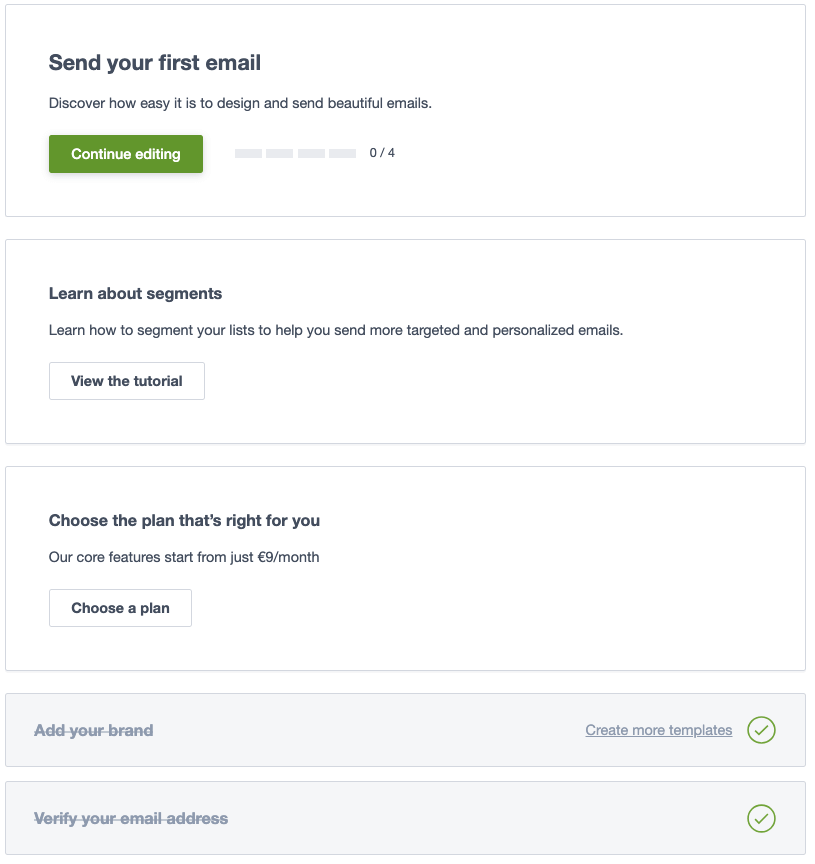
tinyEmail wins. While the signup process has its challenges, tinyEmail is generally more intuitive and much easier to navigate than Campaign Monitor.
Building an email campaign
When it comes to building campaigns, both Campaign Monitor and tinyEmail are pretty intuitive tools with clear drag-and-drop functions.
However, Campaign Monitor’s builder has a limited number of content blocks compared to tinyEmail. The platform only offers the standard blocks like images, text, and buttons. tinyEmail offers a few more interactive content blocks.
For instance, you can add image carousels, countdown timers, and surveys. Campaign Monitor only has a timer content block limited to higher-tier plans.
Both platforms offer an image library with stock pictures to add to your email template. tinyEmail provides an AI text generator to help users, especially those on Shopify, quickly develop subject lines and email copy.
Campaign Monitor also recently launched a generative AI tool called AI Writer to help users generate effective copy for their email campaigns.
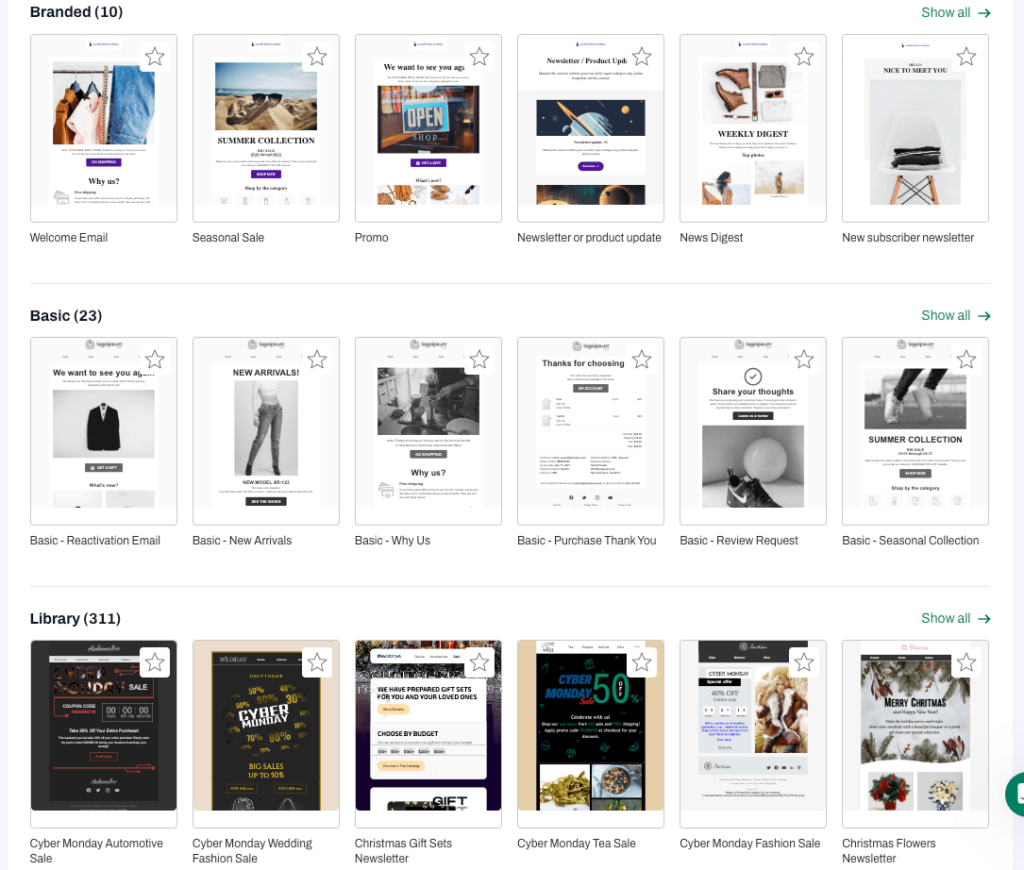
As far as email templates go, tinyEmail provides a list of 300 modern-looking templates for different occasions, while Campaign Monitor provides only 120+. However, with both platforms, you will find decent campaign templates. They aren’t bad.
Using Campaign Monitor, you can send regular campaigns, A/B tests, and basic automation. tinyEmail lacks A/B test campaigns at the moment.
Personalization using merge tags is straightforward on Campaign Monitor and tinyEmail. We only missed a button for a merge tag in the subject lines and preheader sections. Both platforms’ personalization is limited to merge tags. There are no product recommenders or other dynamic content blocks.
Some unique features of Campaign Monitor’s email builder include:
- The ability to lock sections of your template so your team doesn’t edit what you don’t want them to.
- The platform automatically builds three email templates for you using your brand style. This might help when you start using the platform.
- You can add an element to share your campaigns on Facebook and X.
Both builders lack ecommerce marketing features, making them suitable for businesses in other niches.
tinyEmail wins. It offers more templates and is more comprehensive than Campaign Monitor regarding regular email campaigns.
Marketing automation
Both Campaign Monitor and tinyEmail have basic email marketing automation capabilities compared to other advanced tools in the market. However, compared to each other, Campaign Monitor’s email automation feature is a bit more robust than tinyEmail’s.
The platform, unlike tinyEmail, has an easy-to-use visual template builder that allows you to create automation sequences. You can use triggers, set up automation sequences, and include advanced options such as delays and conditional logic.
Campaign Monitor only has one prebuilt workflow, and that’s for the welcome email series.
However, Campaign Monitor provides transactional emails that help small businesses send automated order confirmations, password change messages, etc. This feature is missing on tinyEmail.

Meanwhile, tinyEmail lacks all the above functionalities, as its automation feature is more simplistic.
tinyEmail has very few prebuilt email automation, most of which are only available on Shopify. They’re also not customizable and you can’t edit the logic. Some of these include:
- Abandoned cart series
- Thank you messages
- Product review
- Win-back flow
- Welcome series
Campaign Monitor wins. Though tinyEmail’s functionalities suffice for basic use cases, Campaign Monitor provides a flexible email automation builder that offers more possibilities. However, if you are on Shopify, tinyEmail is a better option.
Signup forms and landing pages
Signup forms and landing pages help businesses build and grow their lists. First, we’ll compare Campaign Monitor vs tinyEmail’s signup forms.
tinyEmail offers a library of prebuilt signup form templates that are modern-looking and you can use to create:
- Popups
- Embedded forms
- Flyouts
However, the signup form builder isn’t the most user-friendly. tinyEmail’s signup form builder appears limited. For instance, it’s not easy to add or change the suggested image, and the settings are limited too. Though basic, Campaign Monitor’s signup form builder is pretty responsive.
On the other hand, Campaign Monitor doesn’t offer any signup form templates. Instead, you’ll get a basic form to customize elements like text, color, font, etc.
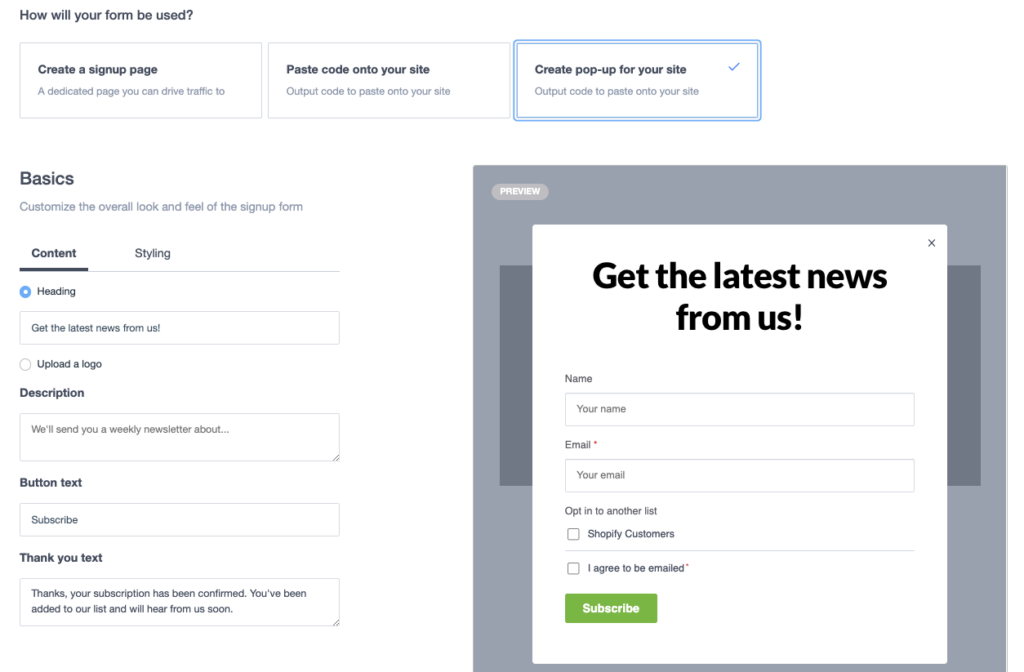
Unfortunately, none of the above tools provide signup form analytics to track list-building performance.
Now, to landing pages. tinyEmail doesn’t provide any, and neither does Campaign Monitor. However, with Campaign Monitor, your signup form can work as your landing page, though the elements would be basic.
List management
On both tinyEmail and Campaign Monitor, list management is pretty straightforward. It’s easy to import and map lists. There’s, however, not much insight into the audiences as none of the platforms provide signup form analytics.
You can also segment these lists, making list management easier on both platforms. However, it’s hard to find the segmentation function on Campaign Monitor.
tinyEmail’s forms look better. Both platforms have areas to improve in regard to signup forms. tinyEmail wins.
Segmentation
Overall, the segmentation functions in tinyEmail and Campaign Monitor appear pretty simple compared to other advanced platforms.
Their criteria for segmenting your audiences is limited. For instance, in tinyEmail, you can only segment users based on their email engagement and customer profile.
Campaign Monitor only allows for the following criteria:
- Subscriber details
- Custom fields
- Engagement
- Campaign activity
- Journey activity
The platform, however, limits the engagement criteria to the highest tier plan.
tinyEmail offers 15 prebuilt segments, four of which are available on the Standard plan and the rest on the Pro plan.
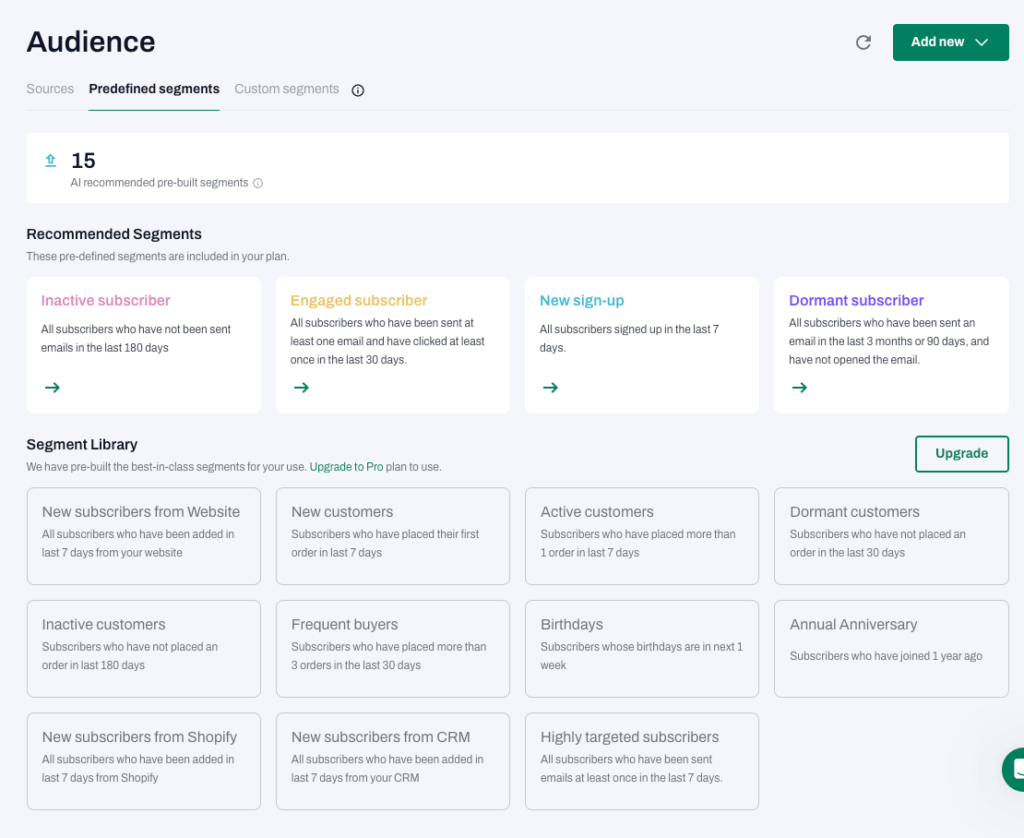
These are suitable for email marketing beginners. Campaign Monitor offers six prebuilt engagement segments only available on the Premier monthly plan.
These include:
- Activity segment
- Engaged subscribers
- Unengaged subscribers
- Dormant subscribers
- Zombies
- Ghost subscribers
Campaign Monitor wins. Though limited, Campaign Monitor provides more segmentation criteria compared to tinyEmail.
Analytics
Both tinyEmail and Campaign Monitor have simple analytics and reporting capabilities. You can track all the standard metrics, such as:
- Open rates
- Click rates
- Delivery rates
- Bounce rates etc
For tinyEmail, Shopify users can track their revenue statistics from their email campaigns. Other than that, tinyEmail doesn’t offer any more ecommerce insights.
Campaign Monitor doesn’t offer any ecommerce statistics either. It, however, offers location reports and real-time analytics, that are missing on tinyEmail.
Campaign Monitor wins since it offers more analytics compared to tinyEmail.
Customer support
tinyEmail offers 24/7 chat and email support for users on both free and paid plans. It also offers onboarding calls to new customers. The platform lacks phone support.
Campaign Monitor, on the other hand, offers 24/7 email and phone support for users on the higher tier plans. There’s, however, no chat support available.
Both platforms offer a list of resources that you can access easily for reference. These include:
- Email Marketing Academy
- Help Center/Knowledge Base
- Blog
- Marketing term glossary
Campaign Monitor has more resources overall compared to tinyEmail. The platform provides webinars, events, community, videos, infographics, and guides.
Both platforms offer 24/7 support which is crucial for many customers.
Integrations
Both platforms offer a sizable number of third-party integrations with popular software, including integrations with ecommerce platforms and CRM tools. tinyEmail lists 20+ integrations, while Campaign Monitor has 100+ ones.
tinyEmail integrates with Shopify, WooCommerce, Magento, and Volusion. Both platforms integrate with CRM platforms like Zoho CRM, Hubspot, and Salesforce as well as accounting platforms like QuickBooks.
tinyEmail allows you to easily migrate from Mailchimp, Campaign Monitor, Drip, Constant Contact, Klaviyo, and MailerLite.
Campaign Monitor wins. It has a longer list of integrations, which means more possibilities.
Compatibility with other marketing channels
Compared to other tools in the market, both tinyEmail and Campaign Monitor have limited compatibility with other marketing channels.
Campaign Monitor recently introduced an SMS integration available to users in the USA. The pricing is, however, not available yet, and you’d need to contact sales.
tinyEmail is currently incompatible with any other marketing channels, although notifications suggest they may introduce the function soon.
Campaign Monitor wins as it provides an SMS integration feature for US users.
Generative AI tools
tinyEmail offers a generative AI tool called tinyAlbert. It helps Shopify users generate subject lines, email content, and themes. It uses GPT-4 AI technology to help make your email marketing easier.
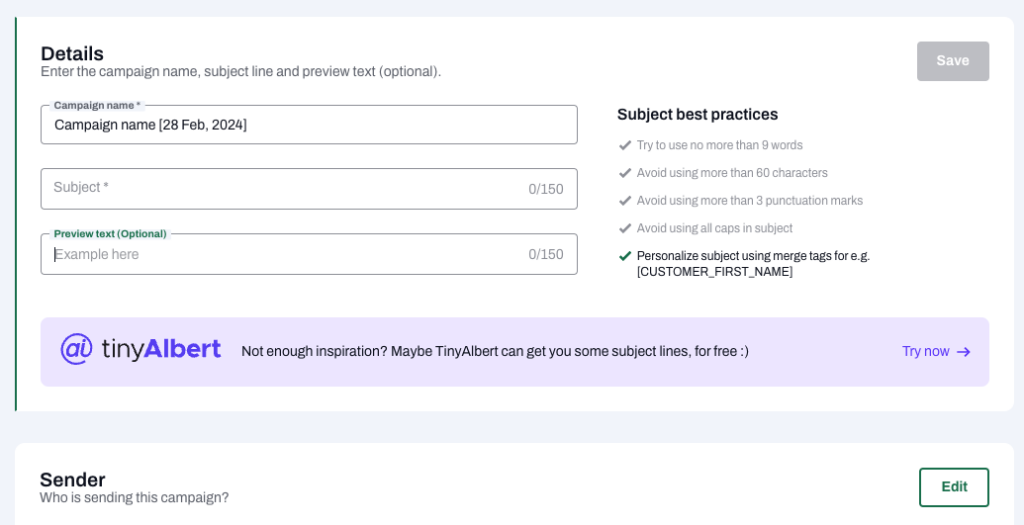
Campaign Monitor’s AI Writer is a generative AI tool that helps users come up with effective email copies with a simple prompt. This tool is available for all users, regardless of your platform.
Campaign Monitor wins because the AI tool is available for all users.
Campaign Monitor vs tinyEmail: Price comparison
Besides features, ease of use, and integrations, your budget is another essential factor when choosing a suitable email marketing platform.
This section discusses Campaign Monitor vs tinyEmail pricing plans and structure. This will help you decide if either tool is within your budget and if they’ll get you your money’s worth.
Free plans comparison
Campaign Monitor doesn’t offer a free plan but a 14-day free trial allowing you to send campaigns to up to five subscribers.
tinyEmail offers a free plan with the following features:
- Up to 5,000 subscribers
- Up to 15,000 email sends
- Automation emails
- Forms and popups
- Limited AI subject line assistant
- Limited sender identities
At the moment, Shopify users also get access to a free Shopify Pro plan that includes features such as:
- Unlimited subscribers
- Unlimited prebuilt segments
- Unlimited AI subject line assistant
- Custom website domain
- Priority support
- Unlimited sender identities
Paid plans comparison
While Campaign Monitor’s pricing is based on the number of contacts on your subscription list, tinyEmail’s pricing plans are based on the number of emails your business sends per month.
From the above pricing comparisons, Campaign Monitor’s prices are pretty high at scale compared to tinyEmail. This is especially so at the beginning as your contact list grows. This makes Campaign Monitor unsuitable for smaller businesses.
tinyEmail is affordable for the most part and only starts to get a bit expensive as the monthly email sends go beyond 100K.
tinyEmail also offers the Shopify Pro plan for free to help small ecommerce businesses get set up. Enterprises that need to send emails in bulk can transfer to the Enterprise plan for custom prices.
Overall, given the features that Campaign Monitor offers compared to more advanced platforms in the market, its prices appear quite high compared to the value offered.
Summary - Which one wins?
Here’s a recap of everything we’ve discussed so far.
3.6
3.5
Free Plan: No
Paid Plans:
- 500 subscribers – $11
- 1,000 subscribers – $39
- 5,000 subscribers – $68
- 10,000 subscribers – $99
- 50,000 subscribers – $349
Free Plan: Yes
Paid Plans:
- Up to 15,000 emails – $15
- Up to 25,000 emails – $25
- Up to 50,000 emails – $50
- Up to 100,000 emails – $100
- Paid plans only
- 14-day free trial
- Up to 500 subscribers
- Up to 15,000 emails
- forms and popups,
- automation emails
- AI subject line assistant
- Limited sender identities
- Easy to use, simple navigation
- Beautiful email templates
- Real-time reporting analytics
- Easy to sign up and use
- Good email builder
- An extended list of email templates
- Good pricing
- Lacks ecommerce insights
- Limited signup form templates
- The price is quite high for the features they offer
- Basic automation and reporting
- Pretty basic segmentation
- Form builder should be improved
- Solopreneurs
- Bloggers
- Non-profit organizations
- Small ecommerce businesses and email marketing beginners
- Bloggers
- Non-profit organizations
- Ecommerce businesses
- Established ecommerce businesses
Now to the overall winner. Which tool is better, Campaign Monitor or tinyEmail?
Campaign Monitor. This platform offers a more developed solution. However, tinyEmail wins on core aspects, like pricing, email builder and signup forms.
Campaign Monitor is suitable for non-ecommerce small to medium-sized businesses looking for email marketing tools. The platform provides attractive email marketing templates, is easy to navigate, and offers real-time reporting analytics.
tinyEmail, on the other hand, is more simplistic and suitable for startups and solopreneurs. It offers basic features at an affordable price for generic and ecommerce email marketing needs.
None of the above tools offers advanced automation, segmentation, or sufficient ecommerce features, so if you’re looking for ecommerce needs, we suggest exploring other options.
Read full reviews
Related picks for you
Our team strives to be accurate and unbiased in reviewing email tools. However, we recognize that mistakes can happen, and it’s essential for us to stay up to date. If you come across any errors or things that need to be reviewed again, please let us know.





Leave a Reply